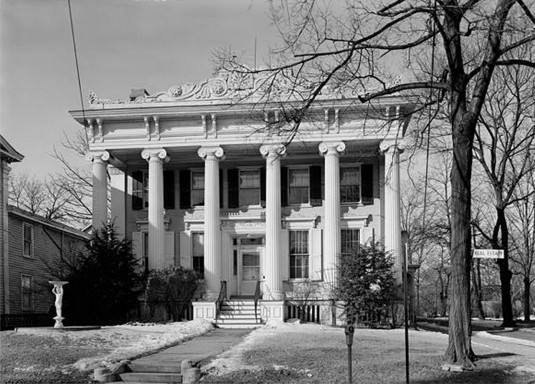In a previous article, I told the story of Martin Kaffitz and his wife Hattie W. Fritts. Kaffitz was employed for many years by William Crater who ran the blacksmith shop in Glen Gardner, Hunterdon County. I learned about the life of Martin Kaffitz from the many entries about him in the Hunterdon Republican newspaper. That paper was equally informative about William Crater, although Crater led a very different sort of life.
architecture
Col. David Bishop
For anyone traveling north on Route 579 from the village of Ringoes in East Amwell, Hunterdon County, there is a landmark that will surely catch your eye, standing opposite the old Bel-Del railroad station. It is a three-story house that was once a showplace but has been deteriorating for at least 25 years. People like me who have been watching it all this time marvel that it is still standing.
Sergeant’s Mills, part three
Being part three in a four-part post about an article written by Egbert T. Bush titled “Sergeant’s Mills Once a Prosperous Place” and published in the Hunterdon County Democrat on January 16, 1930.
Charles George & the Hunterdon Gazette
Thanks to the controversial election of 2016 and recent developments in Washington, people are paying a lot more attention to the news, and coming to appreciate the importance of a free press. This got me thinking about newspapers in Hunterdon County.
Fisher-Reading Mansion

Beautiful, isn’t it? One of the most extraordinary buildings to be found in Flemington, a town with more than its share of great old buildings. It is an outstanding example of Greek Revival architecture.1
A Barn Raising Was A Big Event
Feeding Fifty Men Was Not Uncommon on Such an Occasion
Eatables in Great Abundance
by Egbert T. Bush, Stockton, N.J.
originally published by the Hunterdon Co. Democrat, July 24, 1930
Note: I have included the punctuation as it appeared in the original article, even though I disagree with the editor’s use of commas, and wonder if that was how Mr. Bush wrote it. Also, when Mr. Bush refers to “the young generation,” he means people born in the late-19th and early 20th-century. Mr. Bush was born in 1848.
Old Barns Were Built For The Ages
Processes of Lining, Scoring, Boring and Hewing Described
‘The Big Thrashing Floor’
by Egbert T. Bush, Stockton, N. J.
published in the Hunterdon County Democrat, July 17, 1930
There is no genealogy in this article; it is simply about how to build a barn.
Baptists Divided, or
Who Put the Lock in Locktown?
The Kingwood Baptist Church and the Second Great Awakening
This article is based on an article published many years ago in “Friends Report,” the newsletter of the Friends of the Locktown Stone Church. I have added information and made some major corrections.
The Swamp Meeting House

In the village of Locktown, in Delaware Township, there is a handsome stone church constructed in 1819 in the federal style.
Going Going Gone (3)
The Fulper House on Biser Road
First published in 2013, revised and greatly expanded in 2025.
This house is just about gone. It won’t be long. This past March, I wandered through the honeysuckle and multiflora to try to get some decent pictures, but wasn’t very successful. Sleeping Beauty would never be wakened in that place, it so well guarded by weeds and fallen trees. Sadly, what is probably the oldest part of the house has already caved in. If I could have gotten closer, I might have been able to see some of the old woodwork inside, but that just wasn’t possible.
Caleb Farley’s Headquarters Farm
In this article, Mr. Bush begins with a discussion of the Caleb Farley farm in Headquarters, but strays from the subject of his headline to also discuss a farm just west of Sergeantsville, once owned by the Larew family.